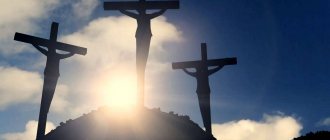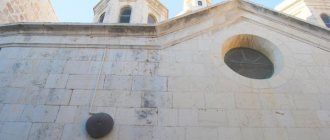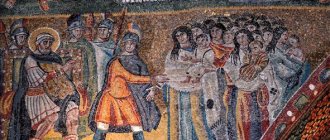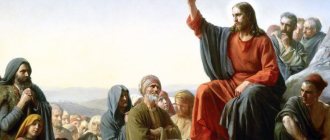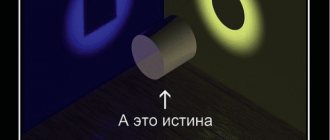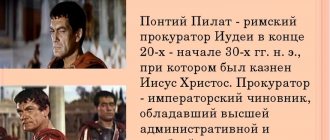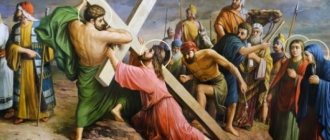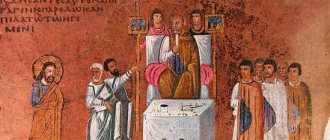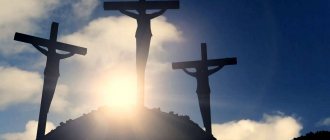Then Pilate took Jesus and ordered him to be beaten. And the soldiers wove a crown of thorns, placed it on His head, and dressed Him in purple, and said: Hail, King of the Jews! And they beat Him on the cheeks.
Pilate went out again and said to them: Behold, I am bringing Him out to you, so that you may know that I do not find any guilt in Him. Then Jesus came out wearing a crown of thorns and a scarlet robe. And Pilate said to them: Behold, Man!
When the high priests and ministers saw Him, they shouted: Crucify Him, crucify Him!
Pilate says to them: Take Him and crucify Him, for I find no guilt in Him.
The Jews answered him: We have a law, and according to our law He must die, because He made Himself the Son of God.
Pilate, hearing this word, became more afraid. And again he entered the praetorium and said to Jesus: Where are you from? But Jesus did not give him an answer.
Pilate says to Him: Do you not answer me? Don’t you know that I have the power to crucify You and the power to release You?
Jesus answered: You would not have any power over Me if it had not been given to you from above; therefore there is greater sin on him who delivered Me to you.
From that time on, Pilate sought to release Him. The Jews shouted: if you let Him go, you are not a friend of Caesar; Anyone who makes himself a king is an opponent of Caesar. Pilate, having heard this word, brought Jesus out and sat down at the judgment seat, in a place called Liphostroton, and in Hebrew Gavvatha. Then it was the Friday before Easter, and it was six o’clock. And Pilate said to the Jews: Behold, your King!
But they shouted: take him, take him, crucify him!
Pilate says to them: Shall I crucify your king?
The high priests answered: We have no king except Caesar.
Then finally he handed Him over to them to be crucified. And they took Jesus and led him away.
And, bearing His cross, He went out to a place called Skull, in Hebrew Golgotha; there they crucified Him and two others with Him, on one side and the other, and in the middle was Jesus. Pilate also wrote the inscription and placed it on the cross. It was written: “Jesus of Nazareth, King of the Jews.” This inscription was read by many of the Jews, because the place where Jesus was crucified was not far from the city, and it was written in Hebrew, Greek, and Roman. The chief priests of the Jews said to Pilate: Do not write: “King of the Jews,” but that He said: “I am the King of the Jews.”
Pilate answered: What I wrote, I wrote.
When the soldiers crucified Jesus, they took His clothes and divided them into four parts, one for each soldier, and a tunic; The tunic was not sewn, but entirely woven on top. So they said to each other: “Let us not tear it apart, but let us cast lots for it, whose it will be, so that what is said in Scripture may be fulfilled: “They divided my garments among themselves, and cast lots for my clothing.” This is what the warriors did.
Standing at the cross of Jesus were His Mother and His Mother’s sister, Mary of Cleophas, and Mary Magdalene. Jesus, seeing His Mother and the disciple standing there, whom He loved, said to His Mother: Woman! Behold, Your son. Then he says to the disciple: Behold, your Mother! And from that time on, this disciple took Her to himself.
After this, Jesus, knowing that everything had already been accomplished so that the Scripture might be fulfilled, says: I thirst. There was a vessel full of vinegar. The soldiers filled a sponge with vinegar and put it on hyssop and brought it to His lips. When Jesus tasted the vinegar, he said, “It is finished!” And, bowing his head, he gave up his spirit.
But since it was Friday then, the Jews, in order not to leave the bodies on the cross on Saturday - for that Saturday was a great day - asked Pilate to break their legs and take them off. So the soldiers came and broke the legs of the first, and of the other who was crucified with Him. But when they came to Jesus, when they saw Him already dead, they did not break His legs, but one of the soldiers pierced His ribs with a spear, and immediately blood and water flowed out.
And he who saw it bore witness, and his testimony is true; he knows that he speaks the truth so that you may believe. For this happened, that the Scripture might be fulfilled: “Let not His bone be broken.” Also in another place the Scripture says: “They will look at Him whom they have pierced.”
After this, Joseph of Arimathea - a disciple of Jesus, but secretly out of fear from the Jews - asked Pilate to remove the body of Jesus; and Pilate allowed it. He went and took down the body of Jesus. Nicodemus, who had previously come to Jesus at night, also came and brought a composition of myrrh and aloes, about a hundred liters. So, they took the body of Jesus and wrapped it in swaddling clothes with incense, as the Jews usually bury. In the place where He was crucified there was a garden, and in the garden there was a new tomb, in which no one had yet been laid. They laid Jesus there for the sake of the Friday of Judea, because the tomb was close.
LiveInternetLiveInternet
Wednesday, April 18, 2012 22:56 + to quote book
Christ is Risen, my dears! For some reason I think about death on Easter days. What is this - the last enemy, behind which is emptiness, or the good, behind which is another life? Jesus Christ gave the world a chance to understand that the soul is eternal. I often think about how quickly people came to believe in Christ. In those days, dissidents were not treated on ceremony; they were punished painfully. And the apostles and the faith of Christ conquered heart after heart, country after country. Not with weapons - with love. This will happen only later, when religion becomes the state religion, forced baptisms begin, and the times of the Crusaders and the Inquisition come. But Christ loved all people, the entire human race - there were only a handful of Christians around him at that time. He preached a religion of love, striving for an ideal. After all, in each of us there is a spark of God, a standard of spiritual beauty. Metropolitan Cornelius in Tallinn, at a sermon before Holy Week, said a surprisingly accurate thought - we all walk with Christ in our hearts, both believers and non-believers. And we all thirst for love and kindness. A note about the Cross was published in the newspaper “Life” in April. She talks about the research of Boris Viktorovich Sapunov, an amazing man, a front-line soldier. His book about the earthly life of Jesus is based on documents, I recommend reading it. In the photo below is Professor Sapunov - ten years ago I took this photo in the Hermitage. “The mystery of the cross of Jesus has been solved. The hidden meaning of the inscription on the instrument of execution of the Savior has been deciphered. Doctor of Historical Sciences Boris Sapunov, a famous art critic from St. Petersburg, revealed the secret meaning of the text of the tablet nailed to the cross on which Jesus Christ was crucified. — Abbreviation of the inscription “I.N.Ts.I.” ““Jesus of Nazareth, King of the Jews” is known to everyone,” says Boris Viktorovich. “But no one could explain why it was written that way.” Now we have managed to shed light on this mystery. 89-year-old Professor Boris Sapunov, chief researcher of the Hermitage, honorary doctor of the University of Oxford, is considered one of the most authoritative researchers of Christ among secular scientists. He is the author of the monograph “The Earthly Life of Jesus,” the first scientific biography of the Savior in Russia. “The church gave money for the first edition of the book,” says Professor Sapunov. – This year the monograph will be published in English in the USA. While working on the biography of Christ, Sapunov used a key unexpected for theologians. He researched the New Testament using military intelligence techniques. “I went through two wars, the Finnish and the Great Patriotic War,” recalls Boris Viktorovich. – Since I know German, I had to interrogate languages. At the front, I learned the main principle of searching for truth - information must be confirmed from several sources. And then, as a historian and art critic, he was a KGB expert on matters related to cultural values. Therefore, the habit of using intelligence and forensic methods is, one might say, in my blood. She helped to look at the gospel texts known for almost two thousand years in a new way. Portrait Professor Sapunov tried to create a verbal portrait of Christ. He made a description of Jesus' appearance, exactly following the Gospel texts. And then, without saying which character we were talking about, he gave the sheet of notes to the forensic experts. “The result was amazing,” Boris Viktorovich shows the image. – The identikit almost exactly matches the face of Jesus from the icon “Savior Not Made by Hands” and the imprint of the face from the Shroud of Turin! A bold experiment confirmed not only that Jesus Christ is a historical character, but also, most importantly, that the evangelists Matthew, Mark, Luke and John are documented accurately. Incident Professor Sapunov solved the riddle of the tablet, which is depicted on each icon of the crucifixion of Jesus, from the standpoint of jurisprudence and criminology. “According to the norms of Roman law, the inscription on the cross of the crucified man was a brief formulation of the sentence passed,” Boris Viktorovich will explain. — The execution of the cross was supposed to have a deterrent effect on all those who would dare to break the law in the future. Sapunov asked himself the question: what Roman laws did Jesus violate and why did the governor, Pontius Pilate, formulate the sentence this way? “The Gospel of Luke says that “the high priests and scribes sought how to destroy Christ... because they were afraid of the people,” argues Boris Viktorovich. — The Gospel of John says that crowds of Jews in Jerusalem persistently demanded the execution of the Teacher of the New Faith. John wrote that the Jews said to Pilate: “We have a law, and according to our law, he must die, because he has made himself the son of God!” But this charge did not fall under the jurisdiction of Roman criminal law and the governor of Rome dismissed it. Then the Jews declared that Jesus declared himself the king of the Jews, and “everyone who makes himself a king is an opponent of Caesar.” Only after this did Pilate “fear” and deliver Jesus into the hands of the Jews. It turns out to be a completely vicious legal incident - the prefect, who publicly stated that he “does not see guilt on this man”, simultaneously agrees to his execution. Well aware that the high priests betrayed Christ “out of envy” (Mark 15.16), Pilate emphasized that “he is not guilty of the blood of this righteous man” (Matthew 17.24). This means that Pilate himself violated Roman laws by passing a death sentence on a man who was not guilty before Rome, whose laws the governor had to observe. Caption - Pontius Pilate, judging by historical chronicles, was cruel, but tried to be fair. - Sapunov continues. “Apparently, that’s why he tried so persistently to save Jesus.” But when he failed, and Christ was crucified, Pilate ordered to write on the board above the head of the executed man in Hebrew, Greek and Latin - “Jesus the Nazarene, King of the Jews” - (I.N.C.I.). That is, Pilate committed an obvious forgery, for he knew perfectly well that such a sentence formula did not correspond to reality! The high priests of Jerusalem also disagreed with Pilate’s formulation. They protested, telling Pilate: “Do not write “king of the Jews,” but what did he say—“I am the king of the Jews.” Pilate answered briefly but firmly: “What I have written, I have written” (John 19.22). The version of the inscription proposed by the priests was also far from the truth - Christ never declared himself king of Judea. It is easy to understand why the Jewish spiritual and secular authorities proposed changing Pilate's formula. If Jesus is the king of Judea, then they have recognized him, and this should lead to immediate war with Rome. If Jesus called himself the king of the Jews, then let him answer for this himself. Pilate's refusal to change the text was not the result of simple stubbornness. He understood that calling himself a king and being a king are not the same thing. With his wording, the prefect created an alibi for himself in the event of another denunciation of the Jews to Rome that he was “not a friend of Caesar.” Any check from Rome on a possible denunciation should immediately have seen that Pilate strictly guarded the integrity of the empire, for he executed the man who was the king of Judea. According to Professor Sapunov, the inscription on the cross as edited by Pontius Pilate contains a whole series of misinformation. — The second letter of the abbreviation “N” is questionable. Jesus is called “Nazarene” - which indicates his birth in the city of Nazareth, says Sapunov. - After all, according to the Gospel records, Jesus was born not in Nazareth, but in Bethlehem. The third and fourth letters of the abbreviation are incorrect. Jesus was neither a king in general nor a king of the Jews in particular. Only the first letter corresponds to reality - the name of the Teacher “Jesus”. The Titlo tablet, as the tablet with the verdict of Jesus is called, was found along with the cross by Empress Helena in the year 326 in Jerusalem. The inscription on it was made in three languages - Aramaic, Greek and Latin. The Russian Orthodox Church, after the reform carried out by Patriarch Nikon, uses the Greek version of the inscription, and the Old Believers still write “King of Glory” on the cross. At first the title was kept in Jerusalem, but during the Crusades it was taken to Europe. Now a fragment of a wooden tablet is in the church of Santa Croce in Jerusalem in Rome. Cross In the Christian tradition, the cross has transformed from an instrument of execution, a symbol of sorrow, into a sign of salvation. In some churches, for example in the Armenian Apostolic, the cross is depicted in bloom - as a symbol of eternal life. It is customary for Orthodox Christians to decorate the image of a cross on Easter cakes baked for Easter, on cottage cheese Easter, and on eggs. After all, Easter is a celebration of the victory of life over death. An attempt to collect all the particles of the Cross into one whole - at least arithmetically - was made at the end of the 19th century. Scientists have calculated the total weight of fragments of the shrine, which have historical evidence of authenticity. Their total weight was only 1.7 kilograms. And in the 20th century, an analysis was carried out of some large particles of the Cross stored in Western Europe. And it turned out that they were all made of olive wood. And according to legend, it was from the olive that the main part of the instrument for the execution of Jesus was made. One of the first particles of the Holy Cross was brought to Rus' by Saint Euphrosyne of Polotsk in the 12th century; it was kept in a precious reliquary. The relic disappeared during the Nazi occupation. Fragments of the Life-Giving Cross are found in many Russian churches. The most famous are in the Annunciation Cathedral in the Moscow Kremlin, in the Moscow Epiphany Cathedral in Elokhov, in the Holy Cross monasteries in Nizhny Novgorod and Yekaterinburg, in the Trinity Cathedral of the Trinity-Sergius Lavra, in the Church of Anastasia the Comforter in Pskov. And in the Resurrection-Feodorovsky convent in the village of Sergeevo near Shuya, a trace of a dried drop of Christ’s blood is visible on a particle of the Tree. Grigory Telnov, first published in the newspaper “Life”.
| Categories: | Religion |
Tags:
Easter Jesus Christ Faith Cross Roman law love crucifixion
Cited 1 time
Like share
0
Like
- I liked the post
- Quoted
- 0
Saved
- Add to quote book
- 0
Save to links
Liked
0
